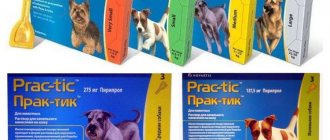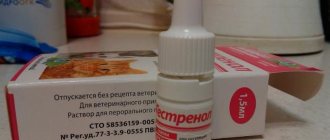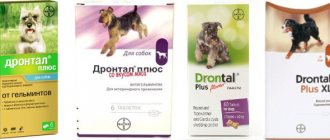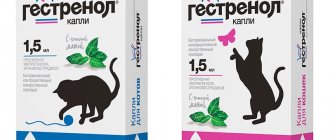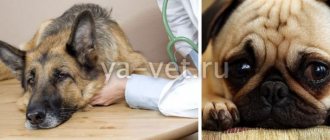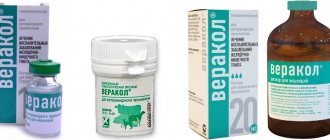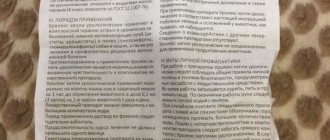Indications for use
The drug anandin for cats is intended for the treatment of infectious pathological processes on the mucous membranes of cats. The drug is used for inflammatory processes:
- in the ears with otitis and otodectosis - tick-borne lesions of the auricles;
- on the mucous membranes of the eyes with conjunctivitis;
- in the nose with rhinitis;
- on the surface of the skin;
- during a complex stage of immunodeficiency.
A sick pet is a misfortune for the owners
All these painful conditions are usually associated with reduced protective functions of the animal’s immune system. With these pathologies, cats experience purulent discharge from the eyes and nose, sneezing and lacrimation, and swelling on the eyelids. Animals begin to be afraid of bright light, they dodge the hands of people when the owners try to stroke their pets on the head, behind the ears. All these symptoms are a signal for an urgent visit to the veterinary clinic.
Important! For treatment, anandin is used as prescribed by a veterinarian after diagnosing and determining the stage of the disease.
Manufacturers of the drug anandin for cats in the instructions for use define it as a means that can prevent the proliferation of pathogens in the cat's body, and recommend its use to strengthen the immune system and prevent diseases. Therefore, it is permissible to use anandin on your own before contacting a pet doctor at the first signs of infection in pets, especially unvaccinated ones and those in contact with street cats. For preventive treatment of animals, 2 drops of the drug are dripped into the nasal and ear canals.
Only a veterinarian can make an accurate diagnosis and prescribe treatment.
Nasal drops for colds
Hypothermia and drafts are the cause of colds in cats. Low immunity contributes to frequent colds. The cat has light mucus flowing from the nose, and the temperature may rise (the paws and ears become hot). She becomes lethargic, lies curled up in a ball, and refuses to eat.
Treatment, first of all, should begin with the creation of comfortable temperature conditions.:
- warm bedding;
- heating the room to 20-22 degrees;
- no draft across the floor.
© shutterstock
Due to a violation of the olfactory function, the animal loses interest in food. To get a cat to eat, you need to rinse its nose. This will restore her sense of smell and make breathing easier. Before this, it is necessary to clear the nasal passages of mucus and crusts with a damp swab soaked in saline solution (1 teaspoon of salt per 100 ml of boiled water). For cats, nasal drops for common colds do not contain antibiotics or immunostimulants.
Types of Drip Irrigation for Cat's Nose:
- infusion of chamomile and sage;
- 0.5% zinc solution;
- 2% boric acid solution.
If the discharge is abundant, then the concentration of boric acid and zinc is increased (3% and 2%, respectively). For thick discharge, you should drip with an aqueous solution of beet juice (1:3), aloe juice. You need to instill 1 drop into each nostril twice a day.
Additionally, local heating of the nasal passages (salt or sand) and pine inhalations are used.
If after 3-5 days of treatment at home there is no relief, or the discharge has become purulent, then you need to show the cat to a veterinarian. The animal must be treated by a specialist. A complication of cold rhinitis can be sinusitis and pneumonia.
Release forms
Kanikvantel for cats: instructions for use
Manufacturer and holder of the registration certificate for Anandin NIO MEDITER LLC (Russia). The list of veterinary products under this name includes:
- eye drops and intranasal drops. The active ingredient is glucaminopropylcarbacridone (anandine), auxiliary components are glycerin, liquid for injection. Available in the form of a transparent liquid of a light green hue. Packaged in individual glass bottles of 5 ml, closed with aluminum caps and rubber stoppers;
- ear drops. They consist of the insecticide permethrin, the antibiotic gramicidin C, anandin and excipients: isopropanol, castor oil, distilled water. The drops have a light yellow tint, are packaged in plastic 5 ml dropper bottles, individually packaged in marked cardboard boxes;
- ear drops plus - modification of ear drops;
- injection solution 10% consists of anandin, water, methylene blue dye. It has a transparent green consistency and a specific smell. Available in 2 types: in ampoules for injections of 1, 2 and 5 ml, which are packaged in ampoule holders, and in sealed bottles of 5, 10 and 100 ml;
- ointment. The composition, in addition to anandin, includes petroleum jelly, castor oil, water, potassium salicylate. The ointment is a light yellow paste and has a slight specific odor. Available in plastic bottles of 10 g, each bottle in a cardboard box.
Note! Each individual package of anandin has instructions for use. The labeling indicates the dates of manufacture and possible storage periods.
Anandin eye and intranasal drops
Release form and composition of the drug anandin
The drug is available in the following versions:
- drops for eyes and nose (glass bottles of 5 ml);
- injection solutions (ampoules of 1, 2, 5 ml in injections);
- drops for ears (5, 10 ml plastic bottles with a nozzle for instillation);
- ointment for external use (10 g plastic bottle).
The solution and drops are represented by a transparent liquid. Only the shades differ:
- light yellow (ear drops);
- green (solution, eye and nasal drops).
The pasty consistency of the ointment is also presented in light yellow color.
The active substance is glucaminopropylcarbacridone, which is an immunostimulant. Most of the substance is contained in injection solutions - 100 mg per 1 ml of medicine. The remaining options contain 20 mg per 1 ml, and ointment – 1 mg.
Mechanism of action
Glucaminopropylacridone is the main component of anandin drugs. With its help, pathogenic bacteria and fungi are destroyed in animals' bodies, inflammatory processes are treated, and the production of interferon is stimulated - a protein that protects living organisms from the invasion of viruses.
Vitafel S for cats: instructions for use
Thanks to the action of the drug in the body, the number of white blood cells and T-lymphocytes, which neutralize harmful microorganisms, increases. The preventive effect of the drug is aimed at increasing the level of animal defenses and preventing associated pathologies.
Important! Anandin is used to treat kittens and adult animals.
Instructions for use of the drug anandin
Anti-inflammatory, regenerative, wound-healing and antimicrobial properties of anandin are present in all types of medicine. The purpose and rules for use of all types of the drug are indicated in the included paper inserts with instructions and duplicated on cardboard boxes. All individual containers with the product are marked with the volume of the substance and expiration date.
Anandin plus ear drops
Cantaren for cats: instructions for use
Used for bacterial and fungal infections of the ears, acute or chronic inflammation of the ears, and tick-borne infections in animals. The course of treatment is 4-7 days. The drug is instilled into the external auditory canal 2-3 times a day, 2-4 drops. Before use, warm the bottle in your hands or with warm water. Procedures should not be interrupted. If an allergic reaction occurs, treatment is suspended and continued only as prescribed by a veterinarian using antihistamines.
The product is used to eliminate itching and inflammatory processes that occur after an attack on animals by pathogens of otodectosis (ear scabies). The drug contains an acaricidal component, is active against ticks, and is used as an antimicrobial medicine.
Before instilling the product into the ear, first the surface of the auricles is cleaned of scabs and dried crusts. To do this, use a bandage or gauze swab soaked in anandin plus. 3 drops of the product are injected into each ear, regardless of whether it has been damaged by insects or not. Do this 2 times a day for 3-4 days. After instillation, the base of the ears is lightly massaged. The course of treatment is repeated after a week.
Eye and intranasal drops
Drops for the treatment of ear and eye inflammatory processes are used in the treatment of rhinitis and conjunctivitis. Anandin containers (nasal drops for cats) do not have built-in dispensers, so you must use a pipette. In case of inflammation of the eye membrane, the product is applied behind the lower eyelid, after first moving it back a little. Directions for use: 2 times a day, 3 drops per procedure. 2-4 drops are instilled into the nasal passage 3 times within 24 hours. The product is used for no more than 14 days.
Note! When using eye drops in the room where the procedure is performed, diffuse lighting is provided so that the animal does not cover its eyes, squinting from the bright light.
Eye drops are applied to the inner surface of the lower eyelid
Ointment for external use
Before using the ointment, antiseptic treatment of the damaged area of the animal’s body is carried out. The wool is not cut, dried crusts are not removed. The medicine is applied in a thin, even layer around and onto the affected area, then the ointment is gently rubbed in.
Before reapplying the drug, the sore spot is washed with saline solution. When removing old remnants of the ointment, try not to injure the newly formed layer of epithelium. The product is used up to 3 times a day for a week.
Important! An animal with an anandin ointment bandage should not be in places where it will be exposed to direct sunlight.
Injection
The intramuscular drug anandin is intended to combat immunodeficiency in pets and is used to treat and prevent viral pathologies. The therapeutic effect of the drug when used in injection solutions occurs within 30 minutes. It is not used for severe renal failure in animals.
For preventive purposes, 5-10 mg of the drug is administered once per 1 kg of body weight. The course of treatment for immunodeficiency lasts from 3 to 6 days. Use 0.2 ml per 1 kg of animal weight once a day. The injection solution is used in complex therapy as prescribed by a veterinarian.
How to give injections to cats correctly
Application procedure
8. Anandin eye drops and intranasal drops are used in the complex therapy of conjunctivitis and rhinitis of various etiologies in dogs and cats.
9. Local use of the dosage form for rhinitis, severe acute serous-purulent and purulent forms of conjunctivitis, chronic and post-traumatic conjunctivitis, alleviates the course of the disease, relieves symptoms of acute local manifestations, reduces the duration of treatment and recovery time. A contraindication to the use of the drug is the increased individual sensitivity of the animal to the components included in the drug.
10. For conjunctivitis, the drug is instilled 2-3 drops behind the lower eyelid twice a day, for rhinitis - 2-4 drops into each nasal passage two to three times a day. Treatment is carried out until the animal recovers, but not more than 14 days. During treatment with the drug, no special conditions for keeping and feeding animals are required.
11. Symptoms of overdose when using the drug were not identified.
12. Peculiarities of action when starting to take the drug and when stopping it have not been established.
13. If the established period for repeated treatments is not observed, the use of the drug should be resumed in the same dosage according to the same scheme.
14. As a rule, there are no side effects and complications when using Anandin eye drops and intranasal drops in accordance with these instructions. If the animal's individual sensitivity to the active components of the drug increases and signs of severe irritation appear, the use of the drug is stopped and, if necessary, antihistamines are prescribed.
15. Anandin eye and intranasal drops are compatible with other medications and feed additives.
16. Since the drug is intended for non-productive animals, the terms of possible use of products of animal origin are not regulated.
Contraindications and side effects
Anandin does not contain allergens, toxic or irritating ingredients; the drug consists of highly active synthetic organic compounds. But the product is not used if pets have individual intolerance to the constituent components, problems with eardrums, or kidney failure. Treatment of lactating and pregnant cats is coordinated with a veterinarian.
Important! When treating with anandine, overdoses of the drug should not be allowed.
Advantages and disadvantages
Anandin for cats is intended for a variety of treatments, can be combined with other medications, is easy to dose, has an affordable price, and can always be purchased at a veterinary pharmacy. Pets do not experience pain when using it. Since the appearance of veterinary drugs on the market, there have been no recorded cases of negative consequences after the correct use of anandin.
Veterinarians consider the disadvantages of anandin to be the impossibility of prescribing long courses of treatment.
Analogs
Animal pharmaceuticals have not yet released analogues of anandin for sale, but there are drugs with a similar effect that veterinarians use to treat pets. AVZ Ciprovet eye drops exhibit an antimicrobial effect in the treatment of eye infections in animals. Claviseptin is used to treat skin infections, and Roborante is used for detoxification.
The drug anandin has established itself as a universal, reliable remedy for the treatment of animals. Despite the fact that there are very few contraindications to its use, it is still undesirable to self-medicate your pets with this remedy.
Active substances and their actions
The composition of Anandin depends on the form of release.
We recommend reading: Dog Has Cramping Muscles in Paws
Eye and intranasal drops: the main substance is glucaminopropylcarbacridone 20 mg/1 ml, activates the formation of interferon, thereby strengthening the pet’s body, relieves inflammation, and has a regenerative effect; additional substances - glycerol 5%, distilled water - up to 100%.
Anandin ear drops: main substances - glucaminopropylcarbacridone 20 mg/1 ml, gramidicin C - 0.05 mg/1 ml, destroys microbes that lead to the development of pathological conditions in the animal; additional substances - isopropanol 0.75 ml, castor oil - 0.04 ml, distilled water - up to 1 ml.
Anandin plus ear drops: main substances - permethrin 0.3 mg, glucaminopropylcarbacridone (anandin) 20 mg, gramicidin C 0.05 mg, additional substances: isopropanol - 0.75 ml, castor oil - 0.04 ml, distilled water - up to 1 ml.
Ointment for external use: main substances - glucaminopropylcarbacridone 20 mg/1 ml; additional substances - petroleum jelly 80%, castor oil 5%, potassium salicylate 0.1%, distilled water up to 100%.
Despite the effectiveness of the drug "Anandin", it is recommended to consult a competent veterinarian before use. Unauthorized treatment of an animal can negatively affect its health. You should contact a specialist immediately after identifying the first symptoms of any disease in your pet.
It so happened that we came across a weak kitten. We live in a private house, he goes outside. Several times during this time I got cat infections, caught a cold, and had to undergo expensive and lengthy treatment. This time I got an infection again, but in addition to a sore throat and fever with snot, conjunctivitis appeared. At first the cat simply squinted his right eye, then there was only pus, and later there was complete horror.
We saw the problem immediately. We rushed to the pharmacy and bought Anandin drops. We went for another proven drug. He wasn't there.
Anandin initially caused a lot of difficulties. Firstly, the packaging is terribly inconvenient. I'm not talking about a cardboard box. Everything is normal here. There are also paper instructions. Everything is in Russian, methods of use are described, detailed information is given. I didn't like the bottle itself.
And not a dropper, and not a pipette. A cap with a spout is placed on a dark glass bottle. It is inconvenient to dose. The cat breaks free, my husband holds it, I open my eye with one hand, and with the other it’s impossible to wriggle free. You won't press on the glass. You press on the lid. The drug flows out in a trickle. The bottle is upside down, the spout is on the side, the stream flies to no one knows where.
About the drug
Trade name: Anandin
Manufacturer: NIO Mediter LLC
Price: about 120 rubles
Purpose: for cats and dogs
We purchased the drug at a regular veterinary pharmacy in the city. I recently went to another location and saw it too. I don't think it's a shortage.
Anandin eye drops and intranasal drops are used to treat conjunctivitis and rhinitis in dogs and cats.
Mode of application:
For conjunctivitis, the drug is instilled in 2-3 drops behind the lower eyelid twice a day, for rhinitis - 2-4 drops in each nasal passage two to three times a day. Treatment is carried out until the animal recovers. The course of treatment is 5-7 days, in rare cases - 10-14 days.
We started treatment when one eye began to leak. There was no pus, no swelling, only light mucous discharge. I hoped that we realized it in time and that everything would pass quickly. But then things started to happen - the cat got worse, snot appeared. For rhinitis, Anandin can also be used. I just can’t imagine how to get into the small nozzle with this spout on the lid.
Can be kept at room temperature. Comfortable. Medicines from the refrigerator constantly have to be heated. I rub my hands vigorously before each instillation.
Shelf life is as long as 2 years. Only we didn't keep anything. The drops ran out very quickly, as they could not adapt to the lid. We treated it for 4-5 days, the cat got worse.
Already during treatment we found the drug “Tsiprovet”. Proven remedy. It can be used for a variety of problems, even injuries. The vet immediately approved. He said that this is the best medicine. I knew this without him. But for some reason there is a shortage in our city.
We recommend reading: Cat Has Sores Under Eyes
Anandin somehow didn’t help us. From the initial stage, conjunctivitis began to progress. My eyes were swollen, stuck together, and unreal torment began. Every day there are trips to the clinic, a lot of injections, then also serums. At home, eye washing, drops, we are all scratched, the animal is exhausted. A lot of nerves were spent. Other health problems also appeared.
Another nuisance was that the cat was in great pain, and when burying it, it flinched as if it had been stung. I suspect I felt a burning sensation. This was not observed when using Tsiprovet.
I've heard a lot of good things about these drops. But, alas, I am telling you about my experience. I was stupid too. It was necessary to immediately pour it into a convenient bottle or use a pipette. But somehow it didn’t come through. Low efficiency + inconvenience of use disappointed me.
Mode of application:
When diagnosing otitis, rhinitis and conjunctivitis of both infectious and allergic nature in cats, Anandin is prescribed. The Russian-made drug has immunomodulatory and healing properties, so it can also be used for post-traumatic conjunctivitis.
Available in the form of ear, intranasal and eye drops. 5 ml bottle. costs 75-80 rubles, and for 10 ml. you will have to pay about 100 rubles. The composition of intranasal and eye drops includes glucaminopropyl carbacridone, which quickly and effectively kills viruses that have entered the body, and also stops inflammatory processes and accelerates the regeneration process. Among the main components of Anandin for the ears is gramicidin, an antibiotic that acts by destroying the protective walls of pathogenic bacteria.
Note! Despite the fact that the compositions of the drops differ only slightly, using the same drug for the ears and eyes is prohibited. Otitis drops are too aggressive for the sensitive membrane of the eyes. But the intranasal form of the drug can also be instilled into the cat’s eyes.
